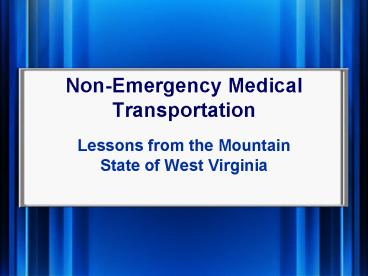NonEmergency Medical Transportation - PowerPoint PPT Presentation
1 / 18
Title:
NonEmergency Medical Transportation
Description:
provides fixed-route and demand response services ... Combination senior services center and transit system for county residents. ... – PowerPoint PPT presentation
Number of Views:355
Avg rating:3.0/5.0
Title: NonEmergency Medical Transportation
1
Non-Emergency Medical Transportation
- Lessons from the Mountain State of West Virginia
2
Background
- a high proportion of emergency
transportation may be for non-emergencies, e.g.,
transporting elderly patients from the nursing
home to the hospital and back again - In Webster County, West Virginia, 1/3 of their
EMS trips are for NEMT.
3
West VirginiaTransportation for Health
- Demonstration funded through the SRAP.
- Additional funding from the 21st Century
Challenge Fund and the Claude Worthington Benedum
Foundation.
4
Definitions
- Fixed-Route Transit Service
- Demand-Response Transit Service
- Deviated-fixed route
- Door-to-Door Service
5
Community Model 1
- Public bus transportation for 5 county service
area. - provides fixed-route and demand response services
- offers route-deviated service , up to ¾ of a mile
from the regular route, when requested in
advance.
6
Community Model 2
- Combination senior services center and transit
system for county residents. - offers route-deviated service, up to ¾ of a mile
from the regular route, when requested in
advance. - in addition to NEMT, provides service to senior
citizens and the County Sheltered Workshop.
7
Community Model 3
- Senior services agency provides services to
county residents. - In addition to NEMT, transports senior citizens
to nutrition sites, shopping, activities, and
medical appointments. - only provider of door-through-door service for
clients, when required and requested in advance. - No fixed route
8
(No Transcript)
9
Who used the services of these providers?
- 70 of riders were female
- Average age 54.9 years
- 36 gt65 y/o, 58 19-64, 6 lt19
- 12 first-time users
10
How was the service paid for?
- Medicaid is the primary payer
- Of the approximately 5000 trips over a 12 month
period - 85 covered by Medicaid
- 28 of Medicaid covered trips for those gt65 y/o.
67 of NEMT riders gt65 are covered by Medicaid.
11
Where are clients going?
- Top three locations
- The doctors office
- Therapy
- Dialysis (Hospital, Tests)
12
How far are clients traveling?
- Average mileage/trip 41.2 miles, std deviation of
another 41.1 miles - 28.6 of NEMT trips are over 51 miles roundtrip
- Miles traveled range from 1 mile to 336 miles
roundtrip
13
Is NEMT paying for itself?
- Not so far.
- Transit authority is the only formal model
approaching break-even, will still require some
degree of subsidy - Larger operation, can spread costs.
14
Differences between providers
- Proportion of traditional transit users
- Methods of collecting sliding fees
- Nature of service
- Curb-to-curb
- Door-to-door
- Door-through-door
- Deadhead miles as a percentage of total
15
Challenges
- Issue 1 Single payer-Medicaid
- Issue 2 Specialty care/treatment not available
locally - Issue 3 Coordination difficulties
16
Possible (not yet proven) Solutions
- Informal/volunteer models (VT Good News Model)
- Broker model connecting rider to the provider,
regional models - Medicare coverage for NEMT
- Subsidize NEMT like traditional mass transit
17
2004 Update
- September 2004. All three programs continue to
offer NEMT services. - The transit authority is the strongest.
18
Conclusions
- The need for cost effective and efficient NEMT is
growing. - More RD is needed
- Policy changes are necessary































